Armenian Art Exhibition 2024,Armenian Church, Chennai
Commemorating the Armenian Genocide on 24 April 2024
Artist - Mari Poghosyan
Cognishift.Org

Commemorating the Armenian Genocide and Pledging to preserve the Armenian Culture and Heritage: A Landmark Exhibition in Chennai
Chennai, India — On April 24, 2024, the historic Armenian Church in Chennai became the venue for an unprecedented cultural event, the Armenian Art Exhibition, commemorating the 109th anniversary of the Armenian Genocide. This landmark exhibition was not only a first of its kind in India but also a profound tribute to the enduring spirit of Armenian culture and history.
Hosted by Cognishift.org
Under the stewardship of Dr. Prashant Madanmohan, Director of Cognishift.org, and Mari Poghosyan, Vice President Cognishift.org , the exhibition was meticulously organized to showcase the rich tapestry of Armenian art and heritage. The setting within the Armenian Church—a beacon of Armenian history in Chennai—added a deeply historical resonance to the event, creating a perfect backdrop for the artworks on display.
Distinguished Guests and Commemorations
The event was graced by notable dignitaries, including Marat Melikyan, the Deputy Ambassador of Armenia to India, and Brindha Sarathy, a celebrated Tamil film screenwriter, artist, and director. Their presence underscored the importance of the exhibition as a bridge between Armenian and Indian cultures. The attendees praised artist Mari Poghosyan for her evocative artworks that vividly brought Armenian cultural narratives to life.
Artworks and Book Releases
Mari Poghosyan’s paintings, from the hauntingly beautiful “Tatev Monastery” to the intricate “Geghard Monastery,” captivated the audience with their depth and beauty. Highlighting the event were two significant book releases: “Armenian Spiritual Sanctuaries” by Prof. Dr. Lems Nersisyan, introduced by the Deputy Ambassador, and “Armenian Legacy in India,” co-authored by Dr. Prashant Madanmohan and Mari Poghosyan, which explores the centuries-old connections between the two cultures.
A Cultural Milestone
This exhibition marked a cultural milestone, being the first such event in India dedicated to Armenian art and the remembrance of the Armenian Genocide. It showcased the power of art to transcend cultural boundaries and serve as a medium for historical and cultural discourse.
Media Coverage and Artwork Features
The Armenian Art Exhibition in Chennai received notable media attention, highlighting the profound cultural and historical significance of the showcased artworks. The “Times of India” provided extensive coverage in both its print and online editions, offering readers a detailed glimpse into the heart of Armenian heritage through the lens of artist Mari Poghosyan. Article Link https://timesofindia.indiatimes.com/city/chennai/armenian-artists-works-to-be-exhibited-in-chennai/articleshow/109538640.cms
Print Edition Features
- Garni Temple and Geghard Monastery: The print edition focused on the stunning depictions of the Garni Temple, the only pre-Christian relic in Armenia, and the Geghard Monastery, intricately nestled in mountainous landscapes. These paintings not only showcased the architectural brilliance of these sites but also reflected the rich tapestry of Armenia’s history and the spiritual depth embedded in its landscape. The inclusion of a duduk on a red carpet with a snowy mountain backdrop beautifully illustrated the fusion of Armenian cultural symbols with its historical narratives.
Online Edition Features
- From the Ashes – Armenian Genocide Memorial: The online edition highlighted “From the Ashes,” a symbolic painting that poignantly commemorates the Armenian Genocide. This artwork features the statue of a mother holding a baby, symbolizing Armenia’s resurgence post-genocide. The use of purple forget-me-nots serves as a reminder of the past atrocities, while red flowers signal the ongoing struggles. This piece effectively evokes a powerful emotional response, reminding viewers of the resilience and mourning that defines much of Armenian history.
Significance of Coverage The dual coverage in both the print and online editions of “The Times of India” not only amplified the reach of this important cultural event but also underscored the relevance of Armenian art in fostering a broader understanding of global historical events and cultural preservation. By featuring Mari Poghosyan’s artworks, the media played a crucial role in educating the public about the importance of remembering and honoring the rich and complex history of Armenia.
Looking Forward
The overwhelming response to the exhibition has set the stage for annual events, promising to deepen the cultural dialogue between Armenia and India. Plans are already underway to expand the scope of these events, further exploring the rich historical ties and shared narratives that link these two ancient cultures.
Join Us Next Time
We are inspired by the community’s interest and enthusiastic participation and look forward to bringing more such events in the future. Stay tuned to our website and social media channels for updates on upcoming exhibitions and cultural initiatives.

Paintings and Artworks on Display

Aseghnagorts Embroidered Khachkhar Acrylic on Canvas painting 50×60cm Original art Mari Poghosyan
Aseghnagorts Embroidered Khachkhar Acrylic on Canvas painting 50×60cm Original art Mari Poghosyan
“Embroidered khachkar” (cross-stone) This amazing stone carving made of tuff is located at Goshavank monastery in Gosh village of Tavush province of Armenia.It was carved by the artist Poghos in the 13th century.
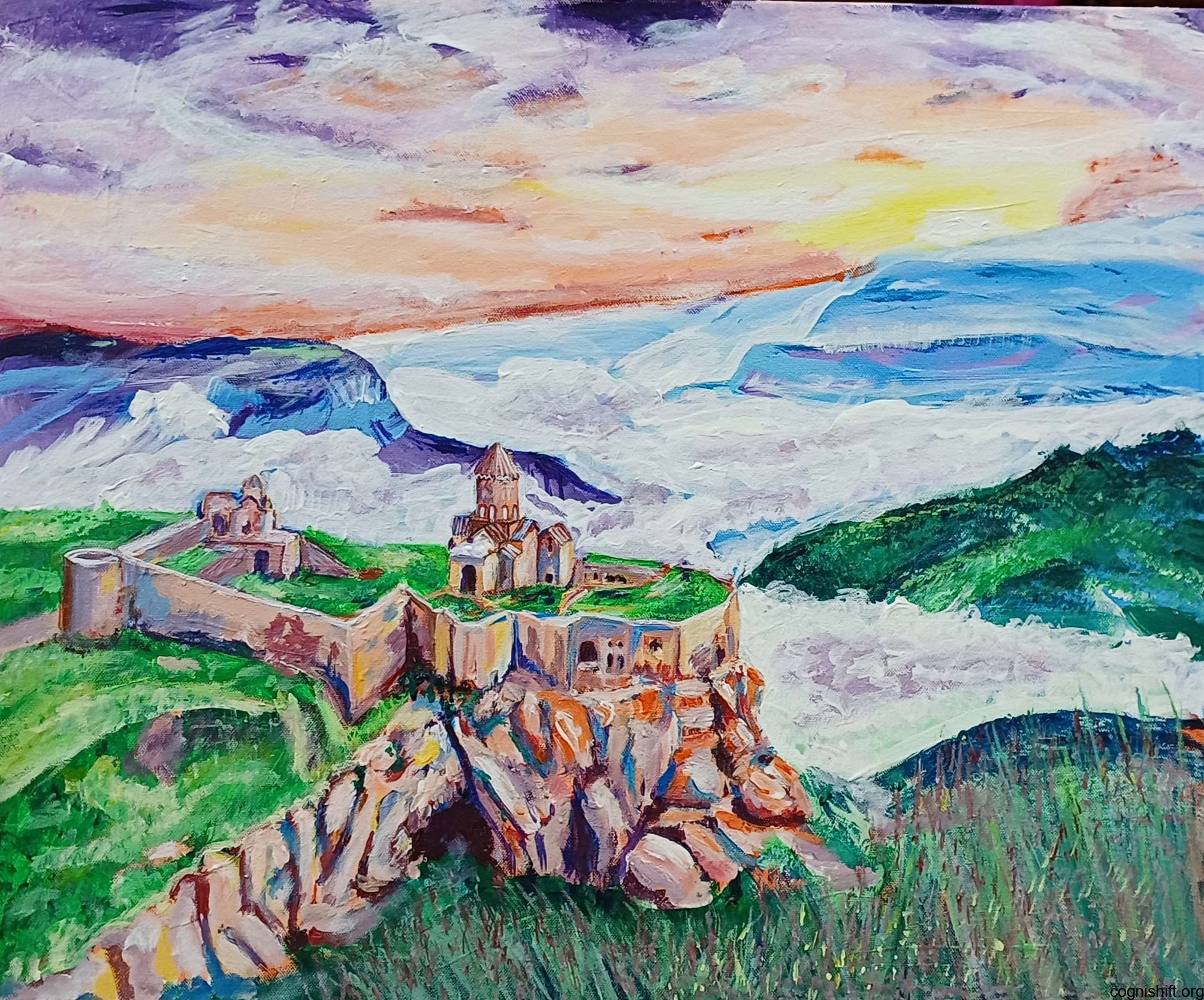
TATEV MONASTERY Acrylic on Canvas painting 50×60cm Original art Mari Poghosyan
TATEV MONASTERY Acrylic on Canvas painting 50×60cm Original art Mari Poghosyan
The Tatev Monastery (Armenian: Տաթևի վանք, romanized: Tat’evi vank’) is a 9th-century Armenian Apostolic Christian monastery located on a large basalt plateau near the village of Tatev in the Syunik Province in southeastern Armenia.
Wiki

Geghard monastery Acrylic on Canvas painting 50×60cm Original art Mari Poghosyan Geghard (Armenian: Գեղարդ, meaning "spear")
Geghard monastery Acrylic on Canvas painting 50×60cm Original art Mari Poghosyan Geghard (Armenian: Գեղարդ, meaning “spear”) is a medieval monastery in the Kotayk province of Armenia, being partially carved out of the adjacent mountain, surrounded by cliffs. It is listed as a UNESCO World Heritage Site with enhanced protection status.
Wiki

Symphony of Armenia Acrylic on Canvas painting 50×60cm Original art Mari Poghosyan
Symphony of Armenia Acrylic on Canvas painting 50×60cm Original art Mari Poghosyan
The painting shows the Ararat mountain in the background and the Khorvirap Monastery, along with fruits which represent Armenia.Also the traditional Armenian Rug with Armenian motifs and ornaments, Also is featured the DUDUK – traditional Armenian musical instrument.
UNESCO proclaimed the Armenian duduk and its music as a Masterpiece of the Intangible Heritage of Humanity in 2005 and inscribed it in 2008. The duduk (/duːˈduːk/ doo-DOOK; Armenian: դուդուկ IPA: [duˈduk])[1] or tsiranapogh (Armenian: ծիրանափող, meaning “apricot-made wind instrument”), is a double reed woodwind instrument made of apricot wood originating from Armenia. Khor Virap (Armenian: Խոր Վիրապ, lit. ‘deep dungeon’[1]) is an Armenian monastery located in the Ararat Plain in Armenia, near the border with Turkey, about 8 kilometres (5.0 mi) south of Artashat, Ararat Province, within the territory of ancient Artaxata.
Wiki
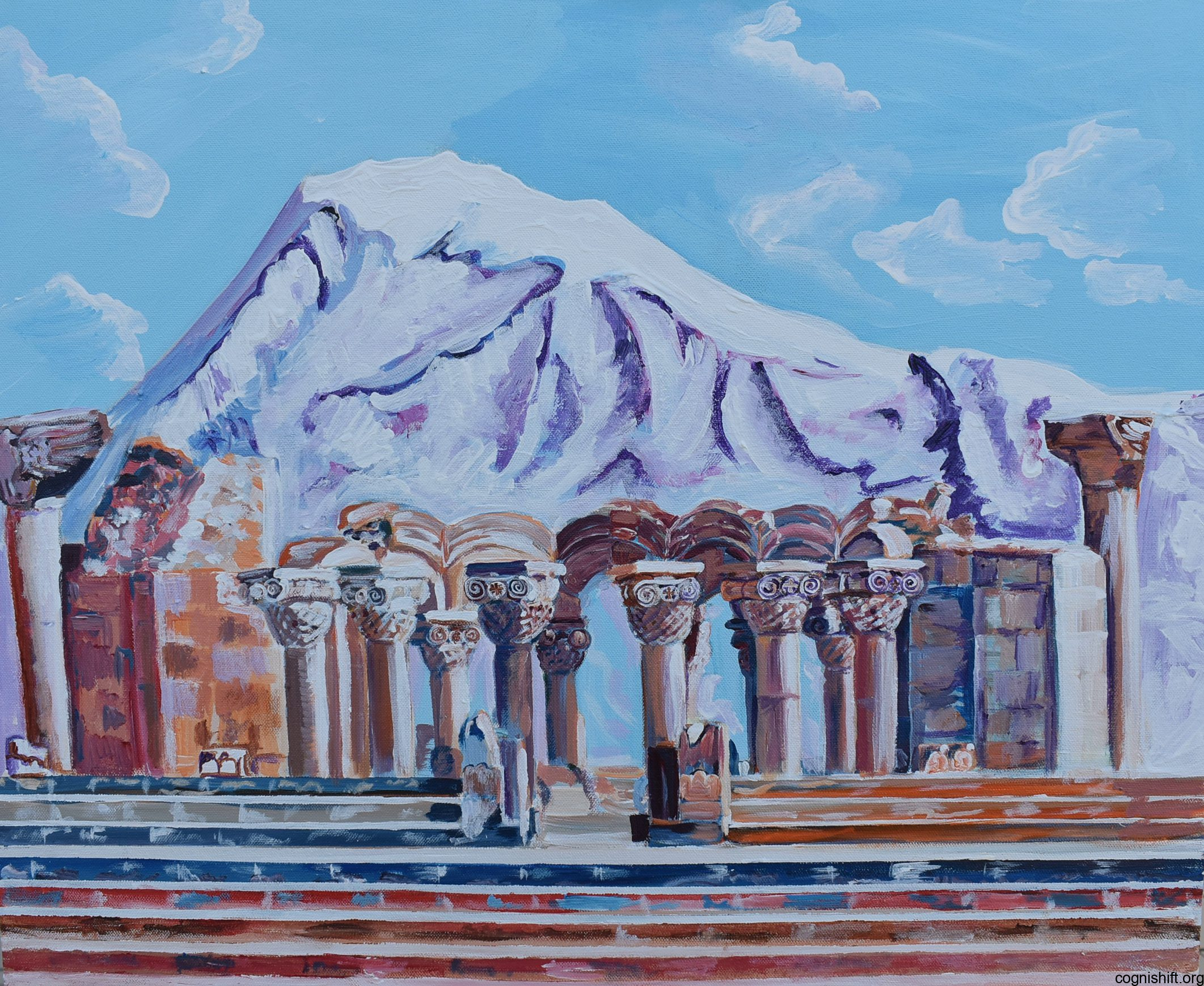
Zvartnots Cathedral Acrylic on Canvas painting 50×60cm Original art Mari Poghosyan
Zvartnots Cathedral
Acrylic on Canvas painting 50×60cm Original art
Mari Poghosyan
Zvartnots Cathedral (Armenian: Զուարթնոց (classical); Զվարթնոց (reformed), sometimes rendered in scholarly works as Zuart’nots’ or Zuart’noc’ ; lit. ‘place of reserection/lifefulness/joyfulness’) is a medieval Armenian cathedral near Vagharshapat (Ejmiatsin), Armenia. Built in the seventh century and now lying in ruins, Zvartnots was noted for its circular exterior structure, unique in medieval Armenian architecture, and a set of interior piers that upheld a multifloor structure crowned with a dome.
Wiki

Noravank Monastery Jan 25 2024 ,Oil painting on canvas, Mari Poghosyan
Noravank Monastery Jan 25 2024 , Oil painting on canvas Mari Poghosyan
Noravank (Armenian: Նորավանք, lit. ’new monastery’) is a 13th-century Armenian monastery, located 122 km from Yerevan in a narrow gorge made by the Amaghu River, near the town of Yeghegnadzor in Armenia. The gorge is known for its tall, sheer, brick-red cliffs, directly across from the monastery.
Wiki

Վանա լիճ, Աղթամարի Սուրբ Խաչ եկեղեցի, Հայ ճարտարապետության կոթողներից մեկը։ Lake Van, Holy Cross Church of Akhtamar, one of the monuments of Armenian architecture. Oil painting on canvas 98x76 cm Original art Mari Poghosyan
Վանա լիճ, Աղթամարի Սուրբ Խաչ եկեղեցի, Հայ ճարտարապետության կոթողներից մեկը։ Lake Van, Holy Cross Church of Akhtamar, one of the monuments of Armenian architecture. Oil painting on canvas 98×76 cm Original art Mari Poghosyan 12 Feb 2024
The Cathedral of the Holy Cross (Armenian: Սուրբ Խաչ եկեղեցի, romanized: Surp Khachʿ egeghetsʿi, Turkish: Akdamar Kilisesi or Surp Haç Kilisesi) on Aghtamar Island, in Lake Van in eastern Turkey, is a medieval Armenian Apostolic cathedral, built as a palatine church for the kings of Vaspurakan and later serving as the seat of the Catholicosate of Aghtamar.
Wiki

Komitas, "Krunk" Acrylic on Canvas painting 50×60cm Original art Mari Poghosyan
Komitas, “Krunk” Acrylic on Canvas painting 50×60cm Original art Mari Poghosyan
Soghomon Soghomonian,[A] ordained and commonly known as Komitas (Armenian: Կոմիտաս; musicologist, composer, arranger, singer, and choirmaster, who is considered the founder of the Armenian national school of music. “Krunk” has become popular, it has become a symbol of longing for the homeland, hospitality and patriotism. “Krunk” is a lyric and lyric-dramatic poem. The words penned with high poetic art were preserved in the 17th century. manuscript in the press
Wiki
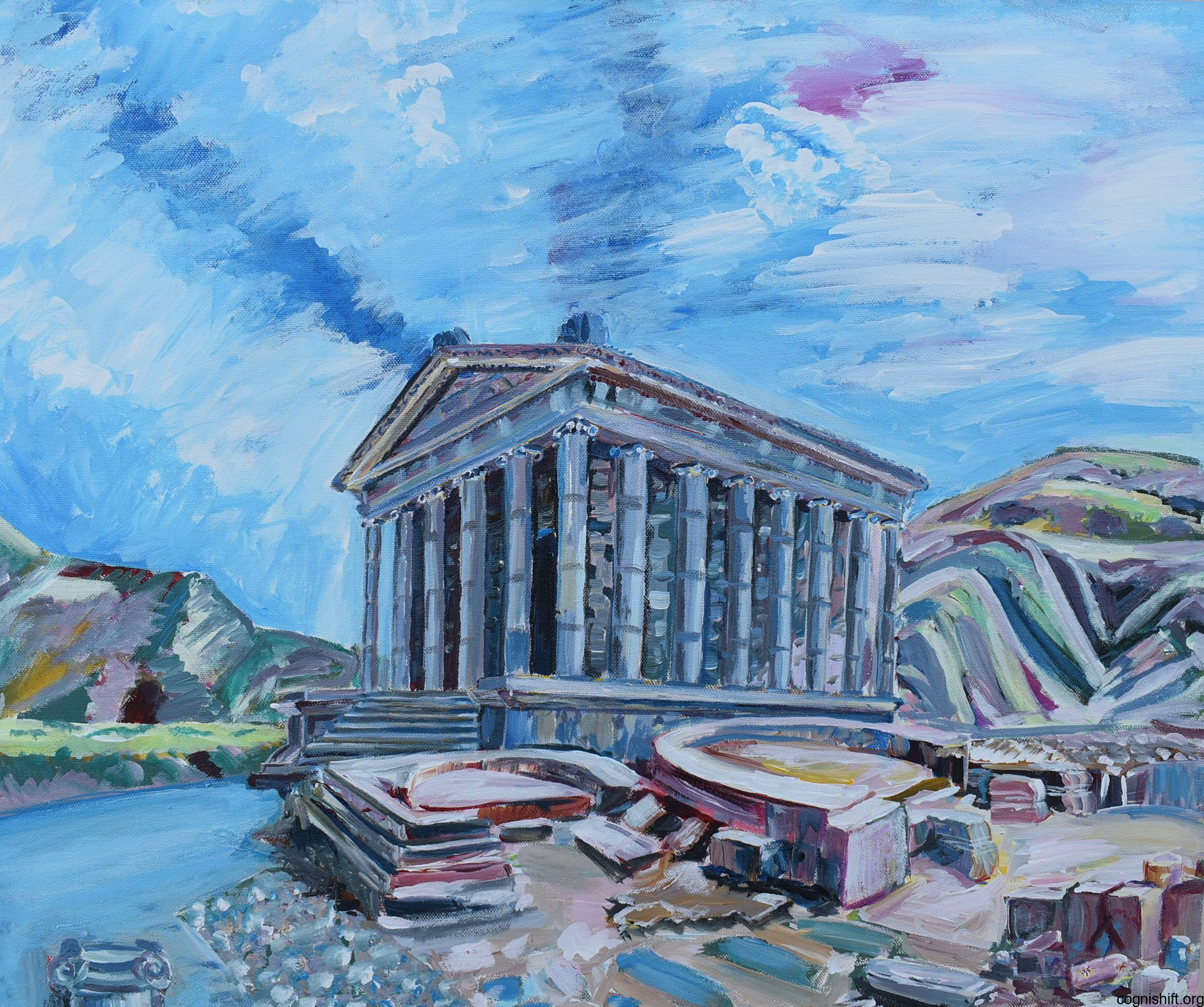
The Garni Temple Acrylic on Canvas painting 50×60cm Original art Mari Poghosyan 27:3:24
The Garni Temple Acrylic on Canvas painting 50×60cm Original art Mari Poghosyan 27:3:24
The Garni Temple is the only standing Greco-Roman colonnaded building in Armenia. Built in the Ionic order, it is located in the village of Garni, in central Armenia, around 30 km (19 mi) east of Yerevan. It is the best-known structure and symbol of pre-Christian Armenia.
Wiki
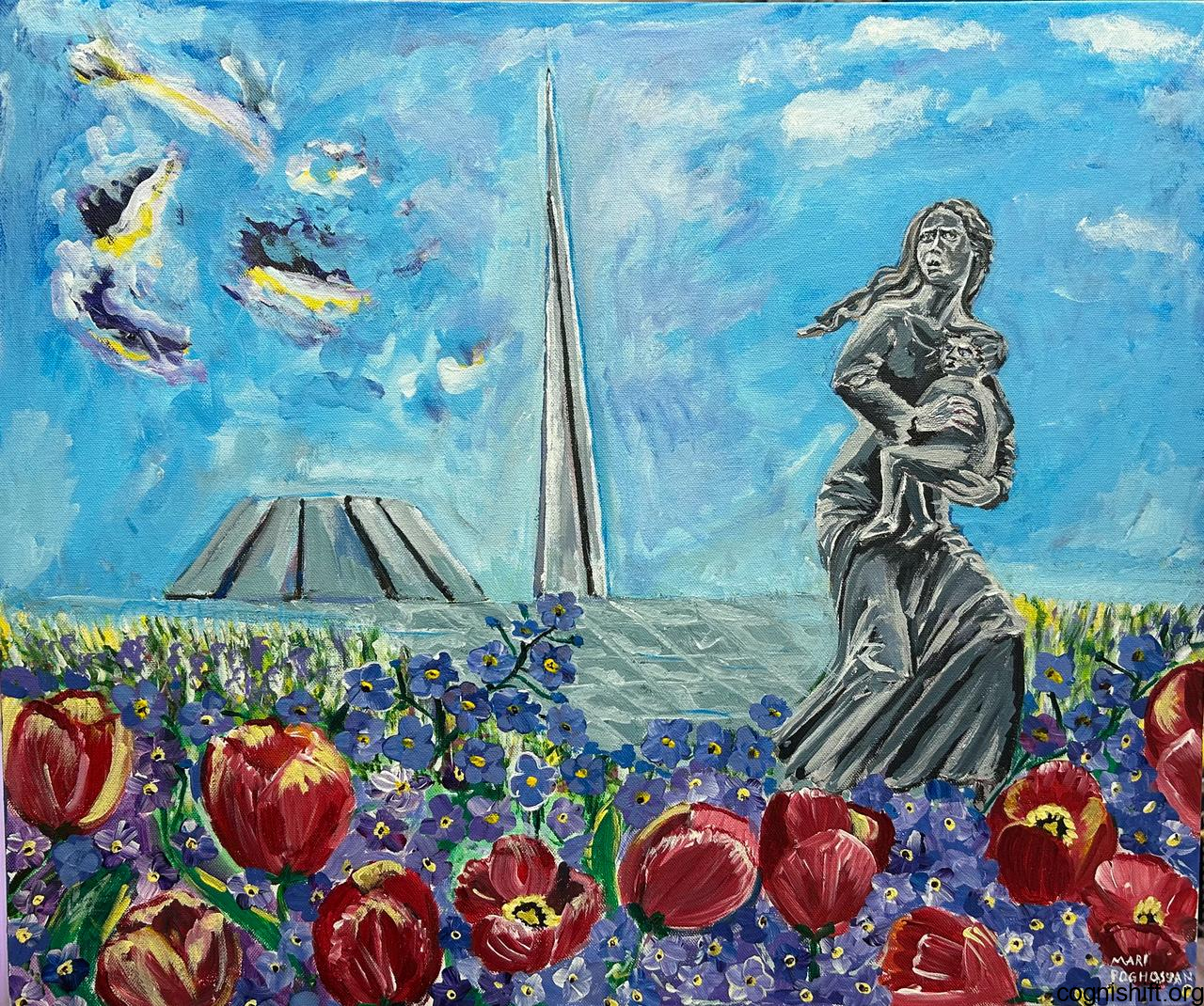
From the Ashes ,Armenian Genocide Memorial Acrylic on Canvas painting 50×60cm Mari Poghosyan 6.02.2024
From the Ashes ,Armenian Genocide Memorial Acrylic on Canvas painting 50×60cm, Mari Poghosyan , 6.02.2024 #art #armenia #ArmenianGenocide
This painting is dedicated to the victims of the Armenian Genocide .
The Armenian Genocide Memorial complex (Armenian: Հայոց ցեղասպանության զոհերի հուշահամալիր, Hayots tseghaspanutyan zoheri hushahamalir, or Ծիծեռնակաբերդ, Tsitsernakaberd) is Armenia‘s official memorial dedicated to the victims of the Armenian genocide, built in 1967 on the hill of Tsitsernakaberd (Armenian: Ծիծեռնակաբերդ) in Yerevan. Every year on 24 April, the Armenian Genocide Remembrance Day, thousands of Armenians gather at the memorial to commemorate the victims of the genocide. The people who gather in Tsiternakaberd lay fresh flowers out of respect for all the people who died in the Armenian genocide. Over the years, from around the world, a wide range of politicians, artists, musicians, athletes, and religious figures have visited the memorial. Also featured in the painting is Mother Arising Out of the Ashes, memorial statue (2002) located in the complex.
Wiki

Amberd Acrylic on Canvas painting 50×60cm Original art Mari Poghosyan Amberd (Armenian: Ամբերդ) is a 10th-century fortress . The name translates to "fortress in the clouds" in Armenian.
Amberd Acrylic on Canvas painting 50×60cm Original art Mari Poghosyan Amberd (Armenian: Ամբերդ) is a 10th-century fortress . The name translates to “fortress in the clouds” in Armenian.
Wiki

Dadivank Armenian Monastery in winter ❄️ ❄️❄️ Original Art , Oil on Canvas, 98 x 69 cm. Mari Poghosyan Jan 31 2024 , Mari Poghosyan
Dadivank Armenian Monastery in winter ![]()
![]()
![]() Original Art , Oil painting on Canvas, 98 x 69 cm. Mari Poghosyan Dadivank (Armenian: Դադիվանք) or Khutavank (Armenian: Խութավանք, lit. ‘monastery on the hill’) is an Armenian Apostolic monastery in the Kalbajar District of Azerbaijan. It was built between the 9th and 13th centuries and is one of the main monastic complexes of medieval Armenia.
Original Art , Oil painting on Canvas, 98 x 69 cm. Mari Poghosyan Dadivank (Armenian: Դադիվանք) or Khutavank (Armenian: Խութավանք, lit. ‘monastery on the hill’) is an Armenian Apostolic monastery in the Kalbajar District of Azerbaijan. It was built between the 9th and 13th centuries and is one of the main monastic complexes of medieval Armenia.
Wiki

Khndzoresk caves, Armenia Oil painting on canvas 98x76 cm Original art Mari Poghosyan
Khndzoresk caves, Armenia Oil painting on canvas 98×76 cm Original art Mari Poghosyan
Khndzoresk (Armenian: Խնձորեսկ, pronounced [χəndzɔˈɾɛsk]) is a village in the Goris Municipality of the Syunik Province in Armenia. The village is located to the east of the Goris–Stepanakert highway, on the steep slopes of Khor Dzor (Deep Gorge), which the village is named after, according to tradition.
Wiki

Artsakh-Rug-Armenian-lady
Artsakh-Rug-Armenian-lady Mari Poghosyan Armenia virtual museum

Pencil sketch SIAMANTO, Mari Poghosyan Armenia virtual museum
Pencil sketch SIAMANTO – great Armenian Siamanto, was an influential Armenian writer, poet and national figure from the late 19th century and early 20th century. Mari Poghosyan Armenia virtual museum

Artsakh Winter costume of a woman
Artsakh Winter costume of a woman Mari Poghosyan Armenia virtual museum
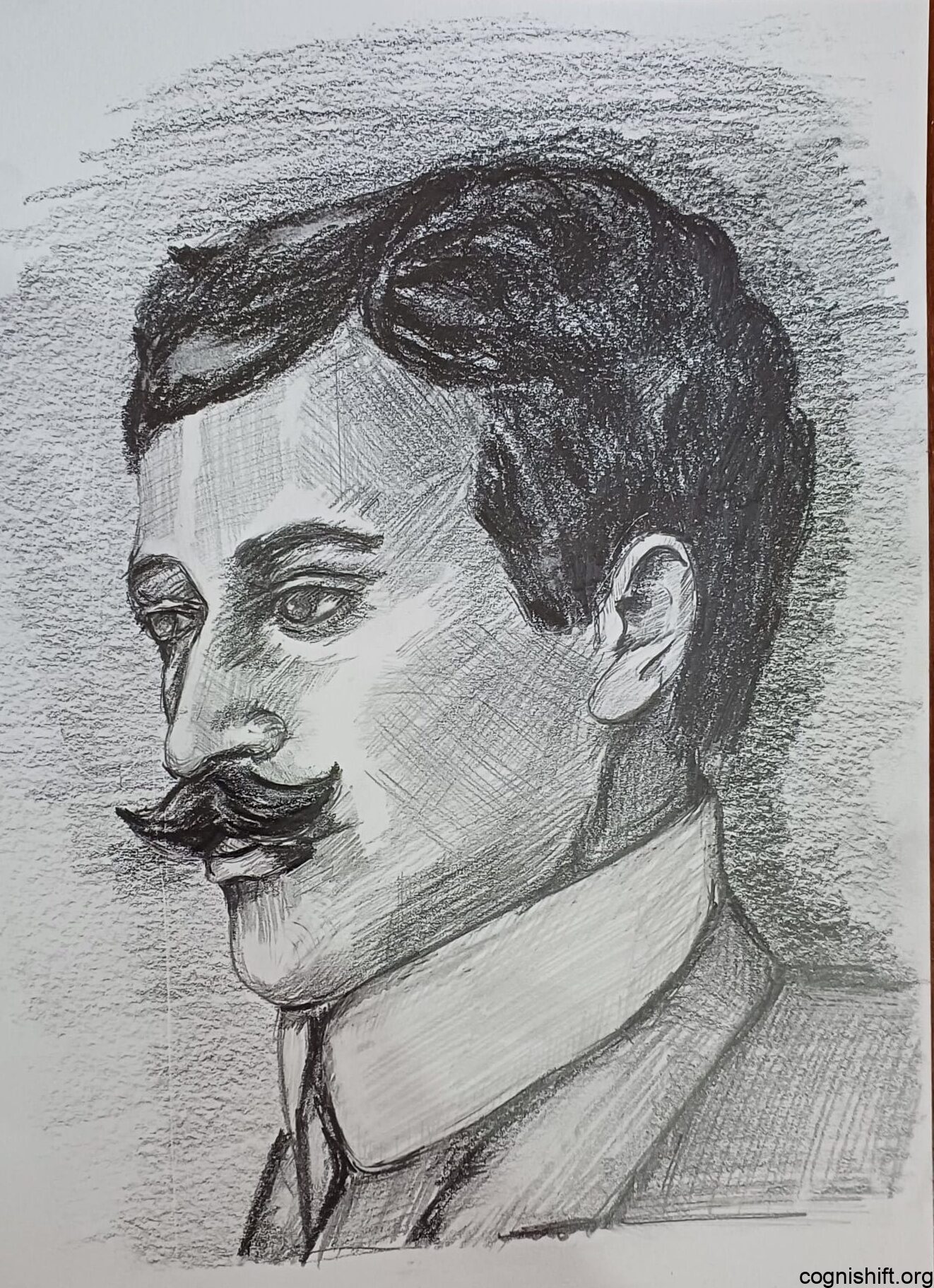
Pencil sketch Daniel Varoujan , Mari Poghosyan Armenia virtual museum
Pencil sketch Daniel Varoujan- great Armenian. Daniel Varoujan was an Armenian poet of the early 20th century. Mari Poghosyan Armenia virtual museum

Artsakh jewellery of a woman
Artsakh jewellery of a woman Mari Poghosyan Armenia virtual museum

































